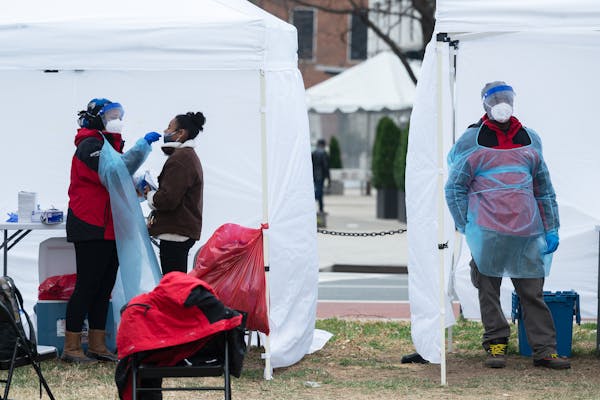Minnesota is reporting a record 15.6% positivity rate for COVID-19 tests conducted in the seven days ending Dec. 30.
The previous record for positivity rate, a key metric of viral spread, occurred early in the pandemic on April 29, 2020, when testing was limited and mostly targeted at meatpacking plants with outbreaks.
Several factors likely inflated the latest figure, including reduced COVID-19 testing during the holiday week. More people also are turning to at-home rapid antigen tests before traveling or visiting relatives, and those results aren't reported to the state. That leaves the remaining reportable forms of COVID-19 tests more likely to identify positives.
Even so, health officials said the latest data reflect the rising toll of the fast-spreading omicron variant and an intense wave of pandemic activity for at least the next month. The state on Friday reported another 33 COVID-19 deaths and 7,833 coronavirus infections, raising its pandemic totals to 10,766 deaths and 1,064,065 infections.
"It's going to be a challenging three weeks or so," Gov. Tim Walz said Thursday when he toured a new free state testing site in Anoka. More than 20 are now available across the state — with some only testing people with appointments and others taking walk-ins.
COVID-19 hospitalization trends have been diverging over the past week — with severe cases in intensive care units declining and COVID-19 admissions in general medical-surgical floors increasing. Minnesota hospitals had 1,467 COVID-19 inpatient cases on Thursday, including 269 COVID-19 patients in intensive care.
Hospitals remain under pressure and the Minnesota Hospital Association on Friday urged people not to go to emergency rooms for COVID-19 tests.
"We have run out of words to describe what we are undergoing," the statement said. "A crisis does not even come close; hospitals are literally full."
Health officials urged more people to seek COVID-19 vaccinations and boosters, which don't entirely prevent infection but do substantially reduce the risk of severe illness, hospitalization and death. Allina Health earlier this week reported that 263 of its 374 COVID-19 hospitalizations involved unvaccinated patients. Of 59 placed on ventilators, 53 were unvaccinated.
The state's hospitals on Thursday reported COVID and non-COVID cases combined to fill up all but 20 of 1,012 available adult ICU beds in Minnesota. State Health Commissioner Jan Malcolm said she is worried that the omicron wave could take up remaining hospital capacity, but she is hopeful that it will follow patterns in other countries, such as South Africa, of a rapid peak and decline.
"Frankly we don't know how all of this will play out in Minnesota in the next few weeks. ... We are watching with concern and alarm with what is happening around the United States and will certainly keep track of any patterns that might help us predict what the likely shape of the curve might be here," she said.
A rapid U.S. peak can't be expected, though, said Dr. Gregory Poland, head of Mayo Clinic's COVID-19 vaccine research group. The environment was very different when omicron took hold in November in South Africa, which had a much later start in its vaccination efforts.
"A lot of South African individuals got infected and had pre-existing immunity, a very different epidemiological context than here in the U.S.," Poland said. "So it's really very difficult to know what is going to happen."
New COVID-19 cases in Minnesota this week include the state's infectious disease director, Kris Ehresmann, who caught the disease, along with her father and husband.
"We were all vaccinated and boosted and thankfully because of the vaccine we all have been able to manage the illness with rest at home," she said.
Ehresmann said she most likely became infected when her father visited her on New Year's Eve for about 15 minutes. He later tested positive for COVID-19 and then revealed he had symptoms of what he thought was a cold before his visit.
"You can't guess what you have. If you have any symptoms ... you need to isolate," she said. "Omicron is spreading rapidly and unfortunately my family is a bad example of how fast it moves."
Staff writer Glenn Howatt contributed to this report.

Minneapolis schools, teachers reach tentative agreement to avert strike
Men knock woman down and steal her dog during walk, St. Paul police say

Minneapolis reaches $150k settlement with eyewitness of George Floyd's murder
He grew up legally in Minnesota, but immigration law gap may one day force student to leave

